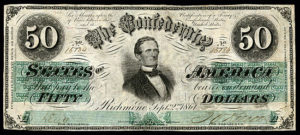What is a Confederate States dollar?

Currency issued just before the outbreak of the American Civil War in the South with high numismatic value in modern times. This currency lacked backing from hard assets but served as a promissory note on the prospect of Southern victory and Independence.
Circulation of the confederate dollar also called a Greyback, began in 1861 just as the Northern and Southern states were drawing up battle lines. At the start of the Civil War, Confederate currency had high purchasing power in the South. However, as the Civil War continued the confederate dollar suffered from bouts of depreciation and inflation as confidence in a Southern victory dwindled.
toward the end of the Civil War, the confederate dollar lost almost all its value as legal tender. This is in part due to the fact that most of the issued currency was not backed by physical assets. In rare circumstances, the issued currency was secured by assets including cotton ad tobacco.
Without access to bank plates, the Confederacy was limited in design capabilities and as a result, there are differences in the appearance of the issued currency. Most often the dollars were hand cut and then signed into legal tender by various clerks. The confederate dollar held designs depicting mythological gods and goddesses, ships, trains, and confederate themes including scenes of Slaves subjected to fieldwork labor. Some greybacks featured well-known individuals including Andrew Jackson, and Jefferson Davis, the Confederate president.
Confederate Treasury banknotes were circulated in the following denominations: 50¢, $1, $2, $5, $10, $20, $50, $100, $500, and $1,000. The total value of the issued currency was approximately $1.7 billion.
Confederacy dollars are considered a high-value collectors’ item. Even though many counterfeit notes were produced during the time of the original issuance, collectors can still expect to pay a high price.
See Also…
Back to All Terms
